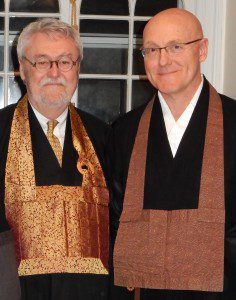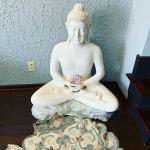 On Friday afternoon, January 23, a small group of us gathered in Worcester, MA, in the Boundless Way Zen library. James Myoun Ford Roshi and his wife, Jan Seymour-Ford (a senior Zen person), and Melissa Blacker and David Rynick (Boundless Way teachers and also roshis), met with Tetsugan and I to discuss our wedding, scheduled for that afternoon, and to consider options for my inka shomei, scheduled for the next afternoon, but now the public portion was in question due to a snow storm bearing down on the area.
On Friday afternoon, January 23, a small group of us gathered in Worcester, MA, in the Boundless Way Zen library. James Myoun Ford Roshi and his wife, Jan Seymour-Ford (a senior Zen person), and Melissa Blacker and David Rynick (Boundless Way teachers and also roshis), met with Tetsugan and I to discuss our wedding, scheduled for that afternoon, and to consider options for my inka shomei, scheduled for the next afternoon, but now the public portion was in question due to a snow storm bearing down on the area.
Before it was clear to some of us what we were going to do, Ford Roshi seamlessly flowed into an impromptu come-as-you-are inka ceremony. Thus I may be the only person who has received inka while sitting in a rocking chair … but probably not the last. Indeed, the one true way may now include the candidate sitting in a rocking chair. Rocking chair or none, we completed the private portion of inka shomei and decided to wait until noon Saturday to cancel the public event.
Then we suited up, changed rooms, and Tetsugan and I got married. What a day!
I am deeply grateful to the Boundless Way community for their support and willingness to include an old Zen hack like me and I’m especially indebted to Ford Roshi, Melissa, David and Josh (Bartok, that is, another of their teachers who planned to come to the Saturday event) for guiding me through the Harada-Yasutani koan curriculum (mostly by obstruction) and for being great friends.
My koan journey began in 1990 at Bukkokuji with Harada Tangen Roshi and included work with Roshis Daido Loori, Daniel Terragno and Bodhin Kjolhede. I am, of course, deeply in debt to them as well for the many kindnesses they offered me (again, mostly by obstruction).
What is “inka shomei” (印可証明)? According to my brother, a Japanese language expert, inka shomei “…literally means ‘evidence of the mark.’ ‘Shomei’ [evidence] is a common term used in law even today. ‘Inka‘s’ two characters mean “mark” and “yes” (as in an affirmation).”
Wikipedia has this gloss: “…the legitimate seal of clearly furnished proof.”
Ford Roshi writes (click for more), “Dosho Roshi was already a successor to the great Dainin Katagiri. This was among other things in acknowledgement of Dosho’s completion and mastery of the Harada Yasutani Soto reform of the Takaju-Hakuin koan curriculum, allowing another Soto lineage to pass on this restored koan tradition.”
Dual lineages are not the norm in Soto Zen today. It’s even against the Soto rules in Japan, although in the old days the founders of the school from Dogen through Keizan were all dual-lineage guys. And it turns out that the Katagiri Dainin Roshi lineage and the Ford Myoun Roshi lineage are surprisingly close – the same through Tokuo Ryoko Zenji (1649-1709). In the last three-hundred years since Tokuo, there have been nine successors in the Katagiri line (including me) and fourteen in the Ford line (through Harada Daiun, Yasutani Hakuun, Yamada Koun, Aitken Chotan, Tarrant Nanryu, and Ford Myoun). They are both Soto lines, although some folks think that this koan introspection lineage is a Rinzai lineage. Not so.
Nevertheless, to receive another lineage in Japanese Soto, a practitioner would need to drop their previous lineage. I want to be clear to my Soto and Katagiri friends, that isn’t what this is about. The training that I did with Katagiri Roshi continues to inform my life, practice, and teaching. I continue to hold the memory of Katagiri Roshi with reverence.
Therefore, my intention is to entangle the lineages together, branching from Tokuo through Katagiri and from Tokuo through Ford. So those who might receive lineage papers, blood lines, from me will have just one lineage.
I was surprised to learn from Jiryu Mark Rutschman-Byler’s excellent master’s thesis, that the great Nineteenth Century Soto master, Nishiari Bokusan, had received inka shomei from another Soto master. So, apparently, there is that precedent. However, inka shomei has continued primarily in the Rinzai school and I’m not aware of this practice continuing in Soto Zen in the Twentieth Century, other than in the Harada Daiun and Kennett Jiyu lines.
Why did I receive another transmission?
From Katagiri Roshi I received the wonderful monastic forms of the tradition and a passion for Dogen study. The transmission from Katagiri Roshi was about how to be a Soto Zen priest.
Katagiri Roshi was a very serious guy. We laughed a lot … and yet there was an underlying dead seriousness about the work. Ford Roshi takes this work seriously while holding himself and others ever so lightly. And so from Ford Roshi I received the wonderful method of koan introspection, of course, and the transmission is about how to be a human being.
John Tarrant Roshi tells this story in The Book of Mu (thanks, Doug, for pointing this out):
Michael Katz related to me a conversation with Gregory Bateson, the thinker and anthropologist. Michael was driving him to a conference at Lindisfarne on Long Island and Bateson said he dreaded something about conferences. “What is that?” asked Michael. “Well, people don’t have a sense of humor.” “What do you mean? What does that mean to you?” Bateson thought about it and said, “A sense of humor depends on knowing that what you think doesn’t really matter, or even that you don’t really matter.”
Ford Roshi really gets that.
I’m tickled that Ford Roshi met Katagiri Roshi at least once. He tells the story in his lovely and important book, If You’re Lucky, Your Heart Will Break: Field Notes from a Zen Life. In the late 196o’s, he lived in the Bay Area and received zazen instruction at the San Francisco Zen Center. He was then invited to sit zazen. Ford Roshi writes,
After that first sitting in the Zen Center, I was ushered into an interview with a senior priest. Dainin Katagiri Roshi, then called by the title sensei, was on duty. I made the bows as I was instructed and sat awkwardly before him. He asked how long I’d been sitting. I estimated three, maybe five minutes. He said, “Good. Keep that mind.”
Katagiri Roshi then rang the bell, ending the meeting.
In addition to the lineage(s) that I may transmit, the upshot of all of this is that I can now officially choose to use the title, Roshi (or not), and can offer koan introspection with full authorization.
So I’ve been practicing for about thirty-eight years, and on the koan journey for twenty-five. Sometimes it does seem like maybe five minutes.
I hear Katagiri Roshi encouraging me, “Good. Keep that in mind.”











